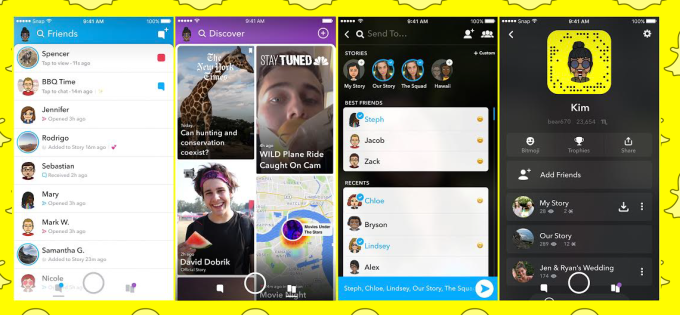The Biggest UX Design Lessons Learnt from Snapchat Redesign Fiasco
The multimedia messaging app, Snapchat rose to popularity in a short span of time. With its peculiar AR-powered camera filters, it has become the most sought after messaging app among youth. Despite being valued at $28 billion dollars when it went public in 2017, the company lost both money and user base because of its recent Snapchat redesign fiasco.
The company altered the design which changed the UX of the entire app. This irked users; More than 1.2 million users signed a petition on Change.org requesting the company to rollback the design changes. The petition’s main complaint is that the new update is ‘confusing,’ ‘it has made many features difficult to use,’ In fact many features are ‘useless.’ Many users even took to social media to express their frustration by posting comments like ‘leaving the app for good.’
In fact, celebrity Kylie Jenner took it to Twitter to share her disappointment with the UX update calling it “sad,” which wiped $1.3 billion off Snapchat’s share price as her 24 million followers agreed with her. But why such adverse reaction? What went wrong?
Why Are Users Against Snapchat Redesign?
The newer version has separated social from media, meaning Snapchat integrated it’s stories and chat features on single screen, naming it FRIENDS page, and changed the original stories page to push branded content. Here are the changes:

- Stories and incoming chats on the same page – The latest redesign compressed Stories and Incoming Chats on one page called FRIENDS. Incoming snapchats are on the top, but the stories and conversations look almost similar and are no longer in serial order. The messaging app uses an algorithm to show Stories from friends it thinks you care most about.
- Sending a message is complex – The new layout is too clumsy and confusing, which makes it tough for the users to find their friends and connect with them. Earlier, it had a simple list of friends.
- Hard to replay the same stories – Rewatching is made difficult with the new redesign. Earlier, if you want to rewatch a story it was available on the Stories page, until its expiry. But now they vanish after one watch. In order to see the stories again, users have to swipe up and search a specific friend’s name to rewatch their Story.
- Featured and sponsored content in place of the Discover page – Earlier, users used to swipe left to find Stories. Now the entire page is dedicated for featured celebrity stories and sponsored content. This move was to make Snapchat more advertiser-friendly and generate more revenue. However, it seems this move has an opposite effect – users can ignore the entire page altogether.
Learnings from the Whole Snapchat Redesign Episode
- User-centric approach: Taking into account user’s need and then merging business needs is what makes any redesign appealing to the users. In other words, balancing user and business goals is essential for a design/redesign successful. However, Snapchat ignored this basic principle of UX design while implementing its redesign that caused a massive damage to its brand image.
- Beta Testing – People don’t like change. That’s known. But for a business to grow change is essential. However, any big change should be a gradual process. Beta testing the revamped work to get target user reactions help businesses gain insights into the functionality of the product. However, Snapchat neglected this too.
The Bottom Line
After all the social media bombardment, if Snapchat wants to grow and regain its lost user base, they need to adopt a makeover, whether it is done by its own team or by a professional UI/UX design company.
Being one of the leading providers of UI/UX design services in New York and Maryland, Infojini adopts user-centric approach to meet the specific needs of every client. We emphasize on making mobile and web UI designs intuitive and representative of the customer’s vision.
Related Posts
- Why UX is Not UI? Answering the Million Dollar Question for the Laymen
- The Business Value of Understanding User Experience the Right Way
- Tips for Enhancing User Experience to Increase Customer Retention for Mobile Apps
Tags In
William B. Young
Subscribe For Updates
Categories
- Accountant
- AI
- Automation
- Awards and Recognitions
- Blue Collar Staffing
- Burnouts
- Campus Recruiting
- Cloud
- Co-Ops agreements
- Company Culture
- Compliance
- contingent workforce
- Contingent Workforce
- COVID-19
- Cyber Security Staffing
- Data Strategy
- Digital Transformation
- direct sourcing
- Distributed Workforce
- Diversity
- Diversity & Inclusion
- Economy
- Events & Conferences
- fleet industry
- Gig Economy
- Girls in Tech
- Global Talent Research and Staffing
- Government
- Healthcare
- Healthcare Staffing
- Hiring Process
- Hiring Trends
- Home Helathcare
- HR
- HR Practices
- HR Tech
- IT
- Labor Shortages
- Life Science
- Local Governments
- News
- Nursing
- Payroll Staffing
- Public Sectors
- Recruiting
- Remote Work
- Skill Gap
- SMB Hiring
- Snowflake
- Staffing
- Staffing Augmentation
- Staffing Challenges
- Talent ROI
- Tech Staffing
- Technology
- Tips & tricks
- Total Talent Management
- UI/UX Design
- Uncategorized
- Veteran Staffing
- Veterans Hiring
- Veterans Hiring
- Workforce Management
Recent Posts
- Automation in Recruiting: From Chatbots to Predictive Screening
- Gig Economy Expansion: The Impact on Talent Pools and Business Models
- Skills-Based Hiring: Why Credentials Alone Don’t Cut It in 2025
- Procurement 3.0: AI & Intelligent Automation in 2025
- Q3 Is Here: Is Your Contingent Workforce Strategy Falling Behind?
Newsletter
Archive
- September 2025
- August 2025
- June 2025
- April 2025
- March 2025
- December 2024
- November 2024
- October 2024
- September 2024
- August 2024
- July 2024
- June 2024
- May 2024
- April 2024
- March 2024
- February 2024
- January 2024
- December 2023
- November 2023
- October 2023
- September 2023
- August 2023
- July 2023
- June 2023
- May 2023
- April 2023
- March 2023
- February 2023
- December 2022
- November 2022
- October 2022
- September 2022
- August 2022
- July 2022
- June 2022
- November 2021
- October 2021
- September 2021
- August 2021
- July 2021
- June 2021
- May 2021
- April 2021
- March 2021
- February 2021
- January 2021
- December 2020
- November 2020
- October 2020
- September 2020
- August 2020
- July 2020
- June 2020
- May 2020
- April 2020
- March 2020
- February 2020
- January 2020
- December 2019
- November 2019
- October 2019
- September 2019
- August 2019
- July 2019
- June 2019
- May 2019
- January 2019
- December 2018
- November 2018
- October 2018
- September 2018
- August 2018
- July 2018
- June 2018
- May 2018
- April 2018
- March 2018
- February 2018
- January 2018
- December 2017
- November 2017
- October 2017
- September 2017
- August 2017
- July 2017
- June 2017
- May 2017
- November 2016
- October 2016



